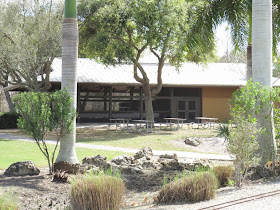Wednesday February 1st
 |
| River Otter with its lunch |
Headed over to Harns Marsh in Lehigh Acres for my monthly Lee County Bird Patrol survey for this venue and was rewarded with a fine day. Spotted a nice male
Snail Kite along Sunshine Parkway, near to arriving at Harns. They have become a bit scarce here lately.

At Harms, I started with a flock of
American Robins accompanied by
Red-belled Woodpecker, Gray Catbird, Mourning Doves, White-eyed Vireo, Blue-Gray Gnatcatcher and a Yellow-bellied Sapsucker. An aggressive pair of
Red-Shouldered Hawks appeared to be driving off a young RSH at the vulture roost.
Gray-headed Swamphens were active along the walk with a couple of
Purple Gallinules as well. While observing a
River Otter munching on a sunfish, one off the purple gallinules came out to investigate what the otter was up too and quickly ran back to cover. Also present today were a large number of
Common Gallinules, Pie-billed Grebes, American Coots, Grackles and Limpkins. Not very many
Red-winged Blackbirds today.
 |
| River Otter |
Due to lowering water levels the number of waders is increasing with
Great Blue Herons, Great Egrets, Cattle Egrets, Tricolored Herons, Roseate Spoonbills, Little Blue Herons, White Ibis and Glossy Ibis. The numbers of
Blue-winged Teal seemed to also be increasing along with about sixty
Ring-billed Ducks and a hand full of
Mottled Ducks. Missed om any black-bellied whistling ducks, but was able to finally sight the lone male
Ruddy Duck others have been reporting.
 |
| American Robin |
 |
| Gray-headed Swamphen |
 |
| Blue-winged Teal |
 |
| Purple Gallinule |
 |
| Ruddy Duck |





























